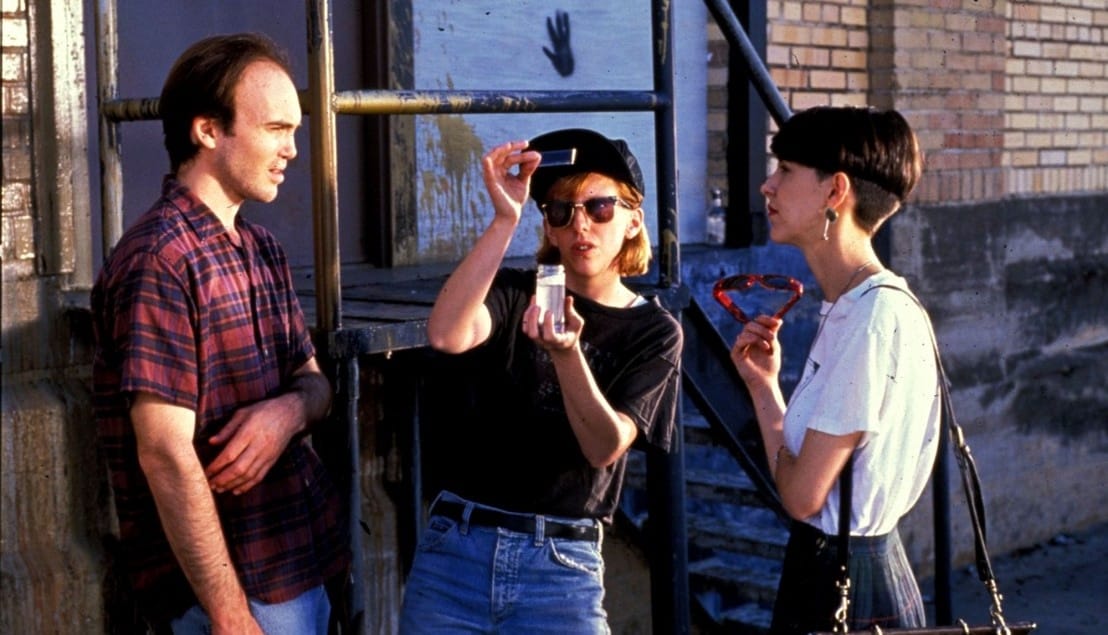Countercultural Meandering: Slacker
Slacker (1990, United States, 97 mins)
Directed by: Richard Linklater
Written by: Richard Linklater
Produced by: Richard Linklater
Cinematography: Lee Daniel
Edited by: Scott Rhodes
Cast: Richard Linklater, Teresa Taylor, Kim Krizan, Mark James, Stella Weir, John Slate, Louis Mackey
The 1990s, in the immortally misguided words of Francis Fukuyama, were “The End of History”[1]. In the face of the fall of the Soviet Union and the apparent total cultural victory of liberal democracy, a general malaise set over the West. What does one do when your way of life appears to have beaten out all others? Unaware of the impending horrors of 9/11 and the War on Terror, raised under the cruel thumb of the newly imposed Neoliberal agenda, Generation X responded to The End of History as naturally as anyone could: with a general sense of apathy and contempt. The almost archetypal image of the 90s slacker – a flannel-wearing, Pavement-listening layabout whose minimum wage job funds a lifestyle of not very much at all – is one that persists well into the 21st century in the hearts and minds of the more nostalgic portions of the population. But stereotypes don’t appear out of thin air. Where did the slacker come from? We can identify them in the music of Guided by Voices or Built To Spill, the cinema of Kevin Smith, but where do they begin? To answer that question, we direct our attention to Austin, Texas in 1985, where aspiring filmmakers Richard Linklater and Lee Daniel are organising a screening of experimental films at the local Dobie 1 & 2 theatre[2].
The Austin Film Society (AFS), before growing to foster independent filmmaking in Texas, began as a simple film club set up by a handful of nerds to show some cool films to their friends. As AFS grew, so did the ambitions of its creators and by 1989, with a feature already under his belt, Richard Linklater was shooting the most ambitious project any of the AFS members had embarked upon yet: a feature film tentatively titled No Longer/Not Yet which would eventually become Slacker (1990)[3]. Linklater and co were inspired by the likes of Jonathan Demme, Jim Jarmusch and John Sayles, a generation of American independent filmmakers who had found not just an audience but success – in the form of national distribution – for their films. Linklater himself would go on to become a figurehead of the subsequent generation of American indie filmmaking but Slacker, the film that put him on the map, had humble beginnings.
With a budget of just $23,000[4], Slacker was a film only made possible by sheer attrition and the willing participation of many of Linklaters friends. The crew was comprised almost entirely of people Linklater knew through the AFS – in particular his close friend and AFS co-founder Lee Daniel who served as cinematographer and provided his own 16mm Arriflex camera as well as a “borrowed” dolly from local public television station KLRU[5]. In Linklater’s own words: “It was purposefully designed around the limitations of its budget. I figured I could get some people to work on it, a real small crew, working sporadically over a two-month period”[6]. The film’s ambitious and experimental carousel structure called for an extensive cast list as well, which Linklater also called in favours for. Linklater and casting director Anne Walker-McBay underwent a lengthy casting process which saw them conduct hundreds of interviews with friends and people they found off the street, casting non-actors almost exclusively – including, of course, Linklater himself[7].
Linklater’s efforts to get the film distributed were similarly scrappy. Before eventually securing a distribution deal with Orion Classics, Linklater had shopped the film at the Independent Feature Film Market (IFFM) in New York and had been rejected by festivals such as Sundance, Berlin, Toronto, Telluride and NYFF. The film found its audience slowly – only 2 people attended its first public screening in the open market section at the Berlin Film Festival[8]. It wasn’t until Slacker was shown at the Seattle Film Festival – where grunge and Gen X counterculture was starting to take hold – that the film began to develop some buzz. By the time the film made its way back to Austin for a sold-out run at the Dobie theatre it was clear that Linklater and co had struck a nerve and the film’s eventual cult status was all but inevitable.
The film itself was groundbreaking for American cinema at the time. Robert Horton noted in an interview with Linklater covering the film that it has a structure reminiscent of La Ronde (1950), Buñuel’s Phantom of Liberty (1974) and Chantal Akerman’s Toute Une Nuit (1982), whereby the film follows different characters from scene to scene with no clear protagonist or narrative. This break from narrative was largely unheard of in American filmmaking at the time and the loose, free-associative structure of the film inadvertently became the perfect format for the film’s exploration of its characters; among them slackers, conspiracy theorists, students, punks, etc.
The focus on dialogue and character rather than plot placed the film firmly in opposition to standard forms of Hollywood filmmaking but looking back now, it set the tone for entire generations of American independent filmmakers to come. It’s no surprise that Kevin Smith credits seeing Slacker as his main source of inspiration for his breakout film Clerks (1994) – another capsule of 90s slacker culture – and the film's influence certainly doesn’t stop there. The Mumblecore movement of the 00s/10s which saw a proliferation of ultra low-budget dialogue-heavy films was largely possible due to the niche that filmmakers like Linklater had carved out years before. Marc Savlov, in a retrospective of Slacker written 20 years after its release, praises Slacker as “American independent filmmaking's closest, truest artistic parallel to Godard's equally untraditional and cinematically electrifying Breathless (1960)”[9].
Linklater, despite his ‘art jock’ image, can be rather neatly positioned as a ‘queer’ filmmaker. Linklater’s films are key influences on New Queer Cinema directors such as Gregg Araki or Gus Van Sant – Van Sant was even a jury member when Slacker screened at Sundance and was one of it’s earliest proponents[10].
‘Slow cinema’ has emerged as a key elaboration of ‘queer time’ in film. Queer filmmakers like Tsai Ming-liang or Apichatpong Weerasethkul have pioneered the ‘slow cinema’ movement, and Linklater’s films feel right at home under that umbrella. Slacker moves at a leisurely pace, allowing the viewer to live with the film's characters as they walk and talk. This meandering manipulation of time is quite queer – not to mention the ways in which the film's eschewal of narrative aligns it with a queer exploration of non-standard modes of storytelling. Despite their ostensible heterosexuality, the characters in the film embody strange and unseen parts of society in a manner which positions them in a particularly queer manner. In putting the actions and conversations which are usually left offscreen at the centre of the film, Linklater makes an investment in displaying the aspects of society which had previously been left out of films. In pairing the film with something like Van Sant’s My Own Private Idaho (1991), a pervasive sense of weirdness comes out, elaborating the many queer aspects of Slacker.
Katarzyna Małecka positions Slacker as a hallmark of 1990s American independent cinema counterculture, framing it in relation to American work culture – particularly as it had manifested in the Reagan era of the 1980s when the film was largely conceived and produced[11]. To uphold Slacker as one of the key texts of the 90s slacker “movement” is not just to say that Linklater and his collaborators were able to accurately reflect the era. At the time when Slacker was made, the era had just begun. There was no concept of the “90s slacker” when Slacker hit theatres, this idea exists largely because of Slacker and the litany of films, music, books it inspired. To say that Slacker was a shaping force of 90s counterculture is not some wild claim, it’s practically fact.
References
[1] Francis Fukuyama, ‘The End of History?’, The National Interest, no. 16 (1989): 3–18.
[2] Alison Macor, ‘Chainsaws, Slackers, and Spy Kids : Thirty Years of Filmmaking in Austin, Texas’, 1 January 2010, 87.
[3] Macor, 95.
[4] Robert Horton, ‘Stranger Than Texas’, Film Comment 26, no. 4 (1 July 1990): 1.
[5] Macor, ‘Chainsaws, Slackers, and Spy Kids : Thirty Years of Filmmaking in Austin, Texas’, 96.
[6] Macor, 96.
[7] Macor, 97.
[8] Macor, 102.
[9] ‘Slack to the Future: Austin Gets Older; “Slacker” Stays Forever Young - Screens - The Austin Chronicle’, accessed 1 November 2024, https://www.austinchronicle.com/screens/2011-01-21/slack-to-the-future/.
[10] Macor, ‘Chainsaws, Slackers, and Spy Kids : Thirty Years of Filmmaking in Austin, Texas’, 109.
[11] Katarzyna Małecka, ‘In Praise of Slacking: Richard Linklater’s Slacker and Kevin Smith’s Clerks as Hallmarks of 1990s American Independent Cinema Counterculture’, Text Matters: A Journal of Literature, Theory and Culture 5 (1 January 2015): 189–204.

